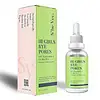What's inside
What's inside
 Key Ingredients
Key Ingredients

 Benefits
Benefits

 Ingredients Side-by-side
Ingredients Side-by-side

Water
Skin ConditioningNiacinamide
SmoothingPropanediol
SolventAlpha-Arbutin
AntioxidantGlycerin
HumectantZinc PCA
HumectantPhenoxyethanol
PreservativeSalix Alba Bark Extract
AstringentPolysorbate 20
EmulsifyingAloe Barbadensis Leaf Extract
EmollientHydroxyethylcellulose
Emulsion StabilisingPotassium Sorbate
PreservativePropolis Extract
Skin ConditioningHypericum Perforatum Extract
AntimicrobialCalendula Officinalis Flower Extract
MaskingAllantoin
Skin ConditioningSalvia Officinalis Leaf Extract
CleansingSodium Benzoate
MaskingWater, Niacinamide, Propanediol, Alpha-Arbutin, Glycerin, Zinc PCA, Phenoxyethanol, Salix Alba Bark Extract, Polysorbate 20, Aloe Barbadensis Leaf Extract, Hydroxyethylcellulose, Potassium Sorbate, Propolis Extract, Hypericum Perforatum Extract, Calendula Officinalis Flower Extract, Allantoin, Salvia Officinalis Leaf Extract, Sodium Benzoate
Water
Skin ConditioningGlycerin
HumectantCaprylic/Capric Triglyceride
MaskingPropanediol
SolventCoco-Caprylate/Caprate
EmollientCaprylyl Glycol
EmollientPentylene Glycol
Skin ConditioningAcrylates/C10-30 Alkyl Acrylate Crosspolymer
Emulsion StabilisingEthylhexylglycerin
Skin ConditioningSodium Lauroyl Lactylate
EmulsifyingTerminalia Chebula Fruit Extract
Skin ConditioningBeta-Glucan
Skin ConditioningSodium PCA
HumectantHumulus Lupulus Extract
AntimicrobialSodium Lactate
BufferingXanthan Gum
EmulsifyingArginine
MaskingAspartic Acid
MaskingPCA
Humectant1,2-Hexanediol
Skin ConditioningCeramide NP
Skin ConditioningGlycine
BufferingCeramide AP
Skin ConditioningPhytosphingosine
Skin ConditioningCholesterol
EmollientAlanine
MaskingCarbomer
Emulsion StabilisingSerine
MaskingValine
MaskingProline
Skin ConditioningThreonine
Isoleucine
Skin ConditioningHistidine
HumectantPhenylalanine
MaskingButylene Glycol
HumectantGlucose
HumectantSodium Hyaluronate
HumectantChondrus Crispus Extract
Skin ConditioningCeramide EOP
Skin ConditioningSodium Hydroxide
BufferingHydroxypropyltrimonium Hyaluronate
Hydrolyzed Hyaluronic Acid
HumectantSodium Acetylated Hyaluronate
HumectantHyaluronic Acid
HumectantSodium Hyaluronate Crosspolymer
HumectantHydrolyzed Sodium Hyaluronate
Skin ConditioningPotassium Hyaluronate
Skin ConditioningWater, Glycerin, Caprylic/Capric Triglyceride, Propanediol, Coco-Caprylate/Caprate, Caprylyl Glycol, Pentylene Glycol, Acrylates/C10-30 Alkyl Acrylate Crosspolymer, Ethylhexylglycerin, Sodium Lauroyl Lactylate, Terminalia Chebula Fruit Extract, Beta-Glucan, Sodium PCA, Humulus Lupulus Extract, Sodium Lactate, Xanthan Gum, Arginine, Aspartic Acid, PCA, 1,2-Hexanediol, Ceramide NP, Glycine, Ceramide AP, Phytosphingosine, Cholesterol, Alanine, Carbomer, Serine, Valine, Proline, Threonine, Isoleucine, Histidine, Phenylalanine, Butylene Glycol, Glucose, Sodium Hyaluronate, Chondrus Crispus Extract, Ceramide EOP, Sodium Hydroxide, Hydroxypropyltrimonium Hyaluronate, Hydrolyzed Hyaluronic Acid, Sodium Acetylated Hyaluronate, Hyaluronic Acid, Sodium Hyaluronate Crosspolymer, Hydrolyzed Sodium Hyaluronate, Potassium Hyaluronate
 Reviews
Reviews

Ingredients Explained
These ingredients are found in both products.
Ingredients higher up in an ingredient list are typically present in a larger amount.
Glycerin is already naturally found in your skin. It helps moisturize and protect your skin.
A study from 2016 found glycerin to be more effective as a humectant than AHAs and hyaluronic acid.
As a humectant, it helps the skin stay hydrated by pulling moisture to your skin. The low molecular weight of glycerin allows it to pull moisture into the deeper layers of your skin.
Hydrated skin improves your skin barrier; Your skin barrier helps protect against irritants and bacteria.
Glycerin has also been found to have antimicrobial and antiviral properties. Due to these properties, glycerin is often used in wound and burn treatments.
In cosmetics, glycerin is usually derived from plants such as soybean or palm. However, it can also be sourced from animals, such as tallow or animal fat.
This ingredient is organic, colorless, odorless, and non-toxic.
Glycerin is the name for this ingredient in American English. British English uses Glycerol/Glycerine.
Learn more about GlycerinPropanediol is an all-star ingredient. It softens, hydrates, and smooths the skin.
It’s often used to:
Propanediol is not likely to cause sensitivity and considered safe to use. It is derived from corn or petroleum with a clear color and no scent.
Learn more about PropanediolWater. It's the most common cosmetic ingredient of all. You'll usually see it at the top of ingredient lists, meaning that it makes up the largest part of the product.
So why is it so popular? Water most often acts as a solvent - this means that it helps dissolve other ingredients into the formulation.
You'll also recognize water as that liquid we all need to stay alive. If you see this, drink a glass of water. Stay hydrated!
Learn more about Water